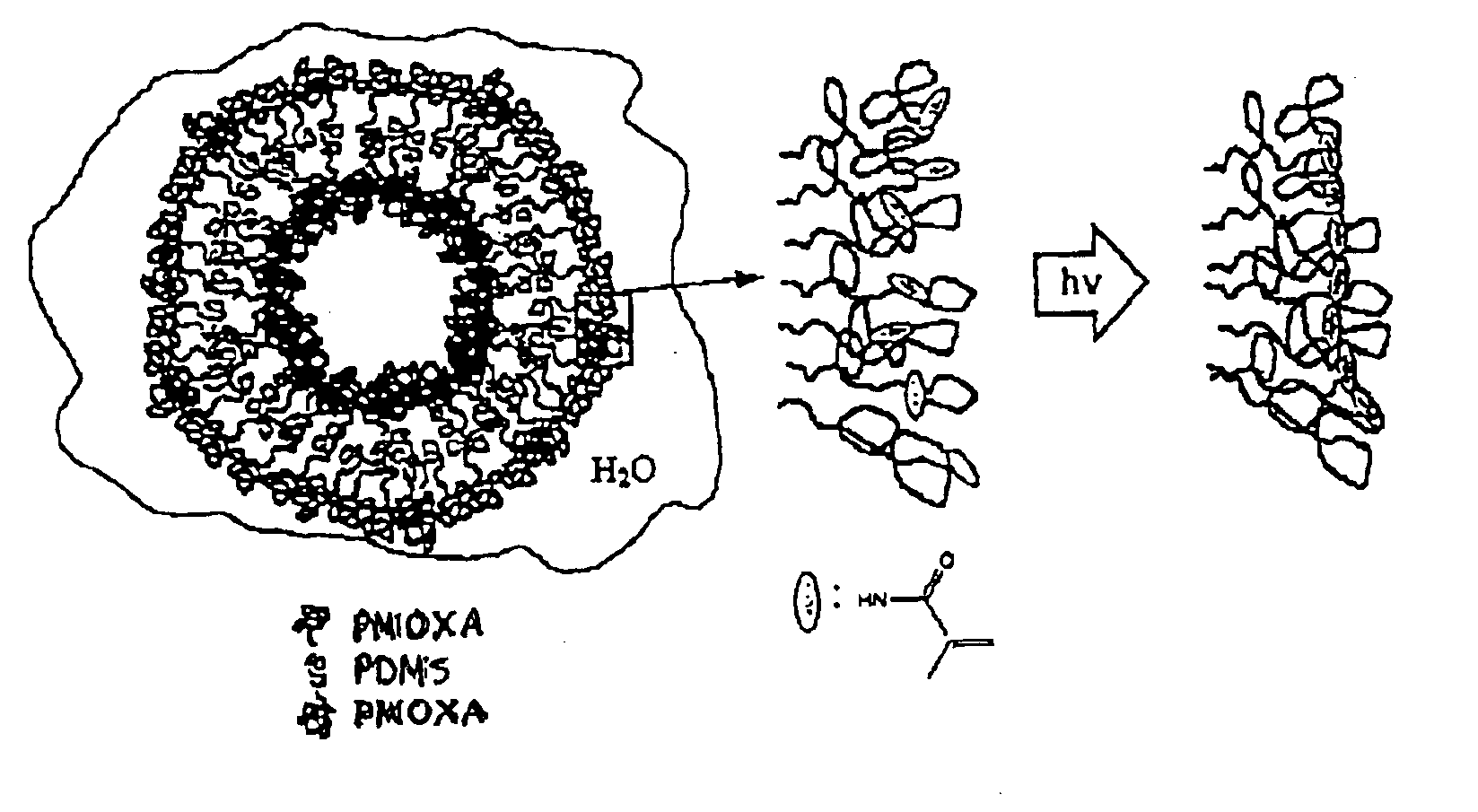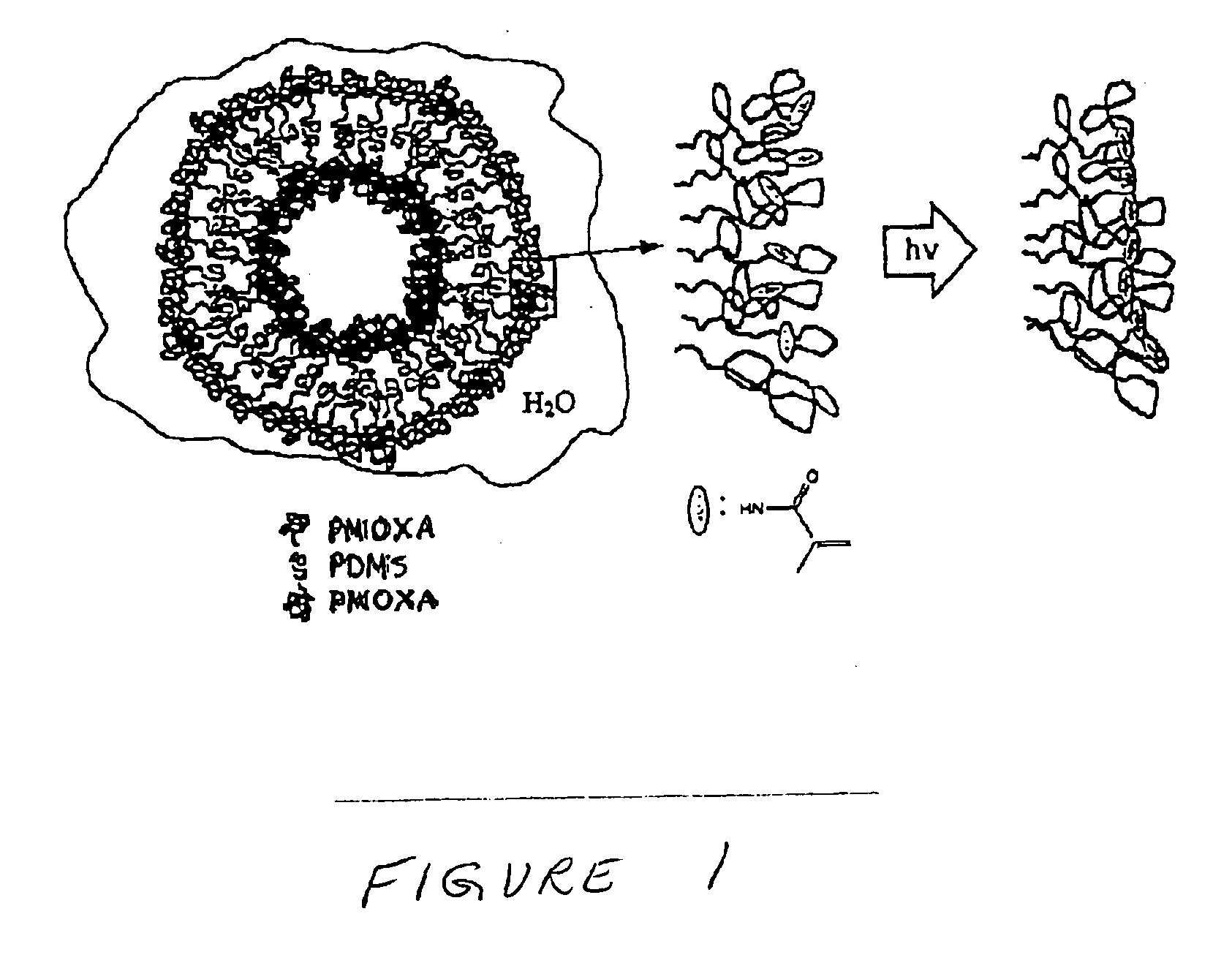Amphiphilic polymeric vesicles
- Summary
- Abstract
- Description
- Claims
- Application Information
AI Technical Summary
Benefits of technology
Problems solved by technology
Method used
Image
Examples
example 1
Synthesis of PMOXA-PDMS-PMOXA Diblock and Triblock Copolymers
[0102]Bifunctional poly(dimethylsiloxane)
[0103]In a 250 mL round bottom two-necked flask with a Soxhlet extractor (filled with molecular sieve (4 A)), a condenser and a septum on the second ground joint, 34.2 g (6.34 mmol) α-ω-bis(3-hydroxypropyl)-polydimethylsiloxane (I−1) were dissolved in 90 mL hexane and distilled under reflux for 17 h in a nitrogen atmosphere. After this drying procedure, the solution still contained 21 ppm water. Subsequently, the solution was concentrated to 60 mL hexane, cooled to 0° C. and 3.6 g (45.5 mmol) of dry pyridine were added. Then, 12.4 g (43.9 mmol) trifluoromethane sulfonic acid anhydride were added over 15 minutes and the mixture was stirred for another 30 min at a temperature of 0° C. After the addition of 20 mL chloroform (water content <10 ppm), the resulting suspension was filtered under vacuum using a G4 glass filter funnel. The solvent was evaporated under high vacuum.
[0104]The y...
example 2
Preparation of Vesicles from PMOXA-PDMS-PMOXA
[0114]The formation of small unilamellar vesicles from the triblock copolymer was achieved according to the following procedure.
[0115]The end-group functionalised PMOXA-PDMS-PMOXA triblock copolymer was dissolved in ethanol to yield a clear, homogeneous solution containing 17 wt % polymer. This solution was added dropwise under vigorous stirring to the respective volume of doubly distilled water. The procedure led to a dispersion of triblock copolymer vesicles of a broad size distribution.
[0116]The polydispersity was reduced by extrusion of the vesicular dispersion through a Nucleopore filters (Millipore) having a pore size of 200 nm.
[0117]Polymerization of the vesicles was achieved by irradiating the dispersion for 15 min with an UV lamp (Ultratech 400 W, wavelength=254 nm, Osram AG). If stored in the dark to prevent their polymerization, the PMOXA-PDMS-PMOXA triblock copolymer vesicles were stable over several weeks and displayed no cha...
example 3
Characterization of Vesicles from PMOXA-PDMS-PMOXA
Freeze-fracture Replication Transmission Electron Microscopy
[0118]A sample of approximately 10 microliters of the vesicle dispersion was brought onto a gold platelet at room temperature and was quenched by hand plunging into a mixture of 15% 2-methyl butane and 85% propane at 83 K. After quenching, the sample was transferred into liquid nitrogen and clamped on a brass block (Balzer). It was mounted on a Balzer freeze etch device (BAF 300), and subsequently the pressure was reduced to 5 10−9 mbar. After evacuation, the sample was fractured with a liquid nitrogen cooled microtome. To enhance the contrast of the surface structure, the sample was warmed to 153 K and etched for 10 min. Thereafter, the sample was cooled again with liquid nitrogen and shadowed with W / Ta under an angle of 30°. After the samples were warmed up to room temperature and brought to atmospheric pressure, the replica was washed with chloroform, put on a 400 mesh co...
PUM
| Property | Measurement | Unit |
|---|---|---|
| Hydrophilicity | aaaaa | aaaaa |
| Hydrophobicity | aaaaa | aaaaa |
| Biodegradability | aaaaa | aaaaa |
Abstract
Description
Claims
Application Information
 Login to View More
Login to View More - R&D
- Intellectual Property
- Life Sciences
- Materials
- Tech Scout
- Unparalleled Data Quality
- Higher Quality Content
- 60% Fewer Hallucinations
Browse by: Latest US Patents, China's latest patents, Technical Efficacy Thesaurus, Application Domain, Technology Topic, Popular Technical Reports.
© 2025 PatSnap. All rights reserved.Legal|Privacy policy|Modern Slavery Act Transparency Statement|Sitemap|About US| Contact US: help@patsnap.com



